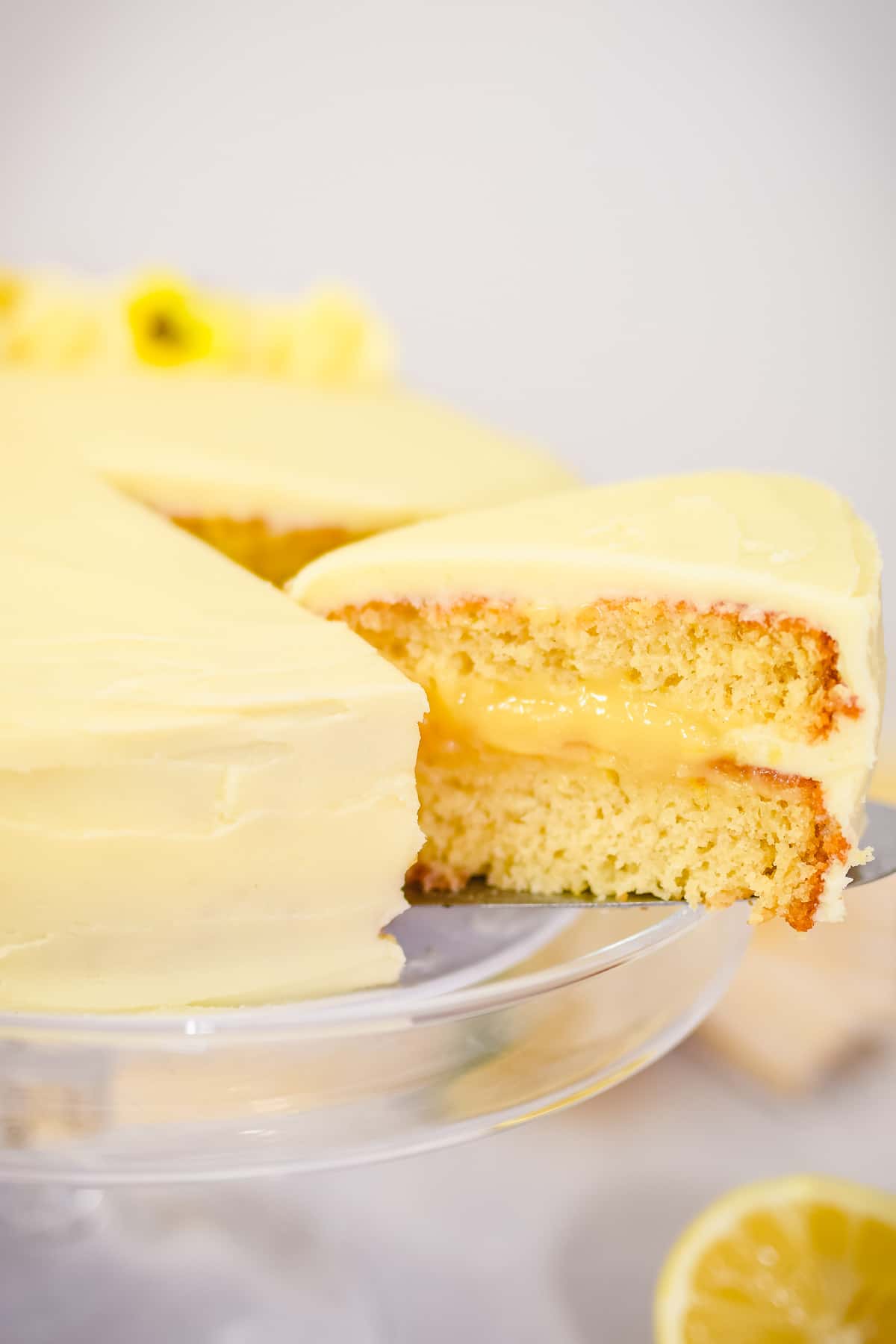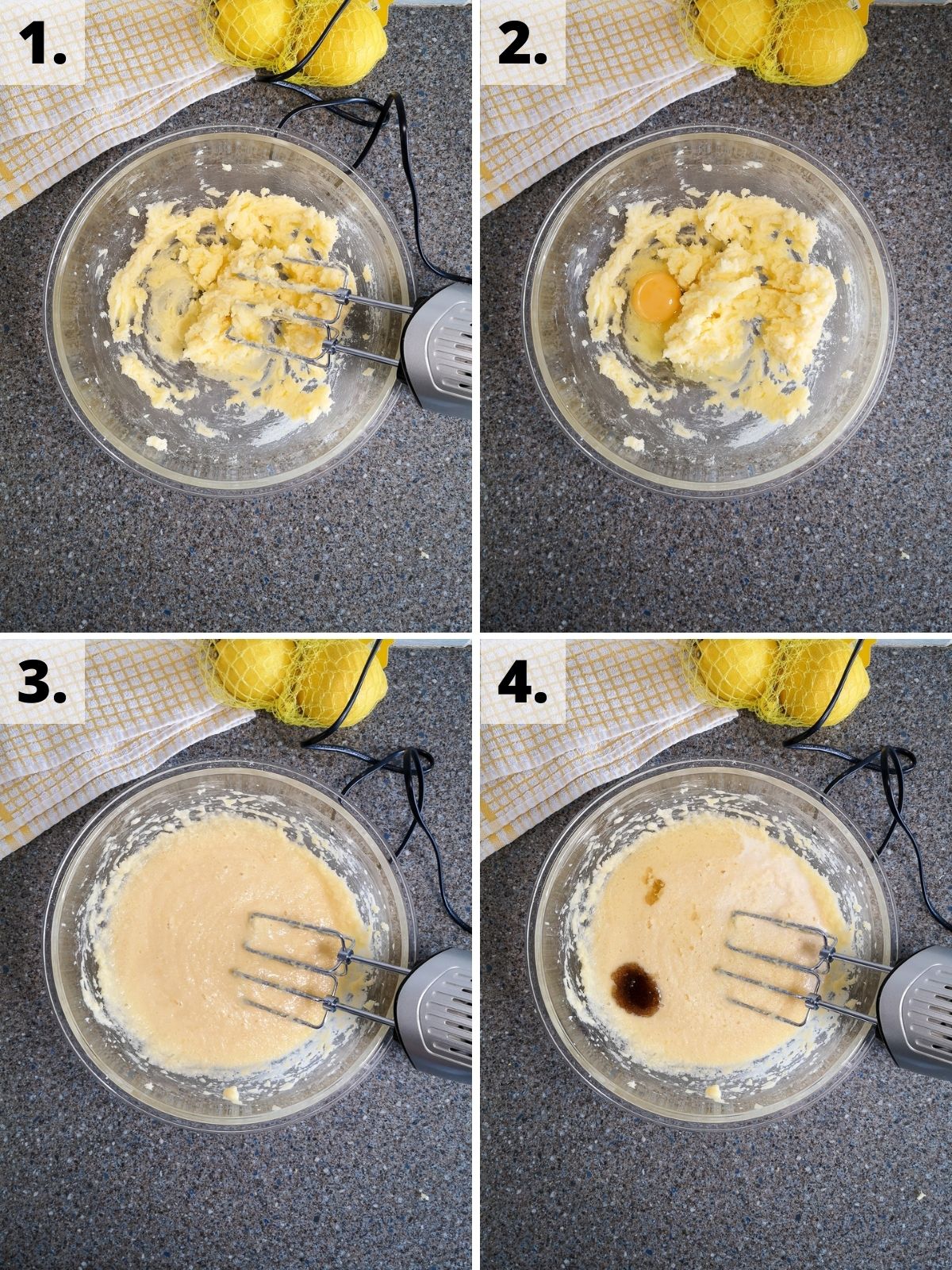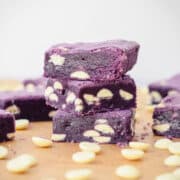A deliciously simple lemon cake with lemon curd filling and lemon buttercream. This 2-layer cake is just bursting with zesty lemon flavour – perfect for lemon lovers!
You can use either store-bought or homemade lemon curd for your cake filling.
This easy lemon sponge cake is a great easy birthday cake. I also love serving this at tea parties, summer picnics and BBQs, especially if you decorate it with cute edible flowers.
It’s also a perfect elegant cake for Mother’s Day too!

Jump to:
✏️ Recipe creation
This is the best easy lemon cake as it has a soft and moist sponge with a creamy lemon curd filling. Frosted with a tangy homemade lemon buttercream too, it’s an explosion of citrusy flavour!
I wanted to create a simple 2-layer sponge cake that could be easily baked and served up for smaller family gatherings and occasions.
Being an 8-inch cake, it’s still a big enough dessert to feed lots of people though!
🥘 Ingredients
This cake recipe calls for the following ingredients:
Lemon cake
- Unsalted butter
- Caster sugar (white finely granulated sugar)
- Lemon zest
- Eggs
- Vanilla extract
- Milk
- Vegetable oil (or other neutral-flavoured oil)
- Plain flour (all-purpose flour)
- Baking powder
Lemon filling
- Lemon curd (store-bought or homemade)
Lemon buttercream
- Unsalted butter
- Icing sugar (powdered confectioners’ sugar)
- Fresh lemon juice
- Milk or cream (optional, depending on consistency)
- Salt (optional)
Decorations
- Lemon (slices or candied peel)
- Edible flowers (optional)
See the recipe card for quantities.
Ingredient substitutions
This recipe is for a homemade lemon cake and lemon frosting from scratch.
However, you can instead swap either the cake or frosting for a store-bought version. You can also use a white cake boxed mix and add your own lemon zest per this recipe to flavour it.
You can also make your own lemon cake filling using my best ever lemon curd cake filling recipe (tastier and thicker!) or buy a premade jar of lemon curd (easier).
I like to use a golden or white caster sugar for this cake recipe, but you can instead swap this for light brown soft sugar instead. This will give it a tasty caramel hint.
You can use any neutral flavoured oil for the cake sponge, such as vegetable, canola or sunflower.
Ingredient tips
- It’s easier to mix room temperature ingredients, so be sure to take your butter and eggs out of the fridge before use.
- Using unsalted butter lets you control the amount of salt in your cake and buttercream. I like mine to be fairly low salt, but you can add an optional ⅛ teaspoon or a pinch of salt to taste in the cake batter and/or frosting.
- I recommend sieving your flour, baking powder and powdered sugar (a.k.a icing sugar or confectioners’ sugar) for a smooth sponge batter and frosting.
- For accuracy, it’s best to weigh your ingredients rather than using cups.
- I prefer using vanilla extract to vanilla essence. It’s less processed, giving it a purer vanilla taste.
- Make sure you use unwaxed lemons for your lemon zest. You don’t want to be eating wax!
- Your cake and frosting will have a better flavour if you use ripe lemons. Make sure they’re a nice bright yellow (not green!).
🔪 Equipment
I use the following equipment for this recipe:
- 8inch / 20cm round cake pans (x2)
- Parchment paper (greaseproof paper)
- Electric hand mixer or stand mixer
- Large and medium mixing bowls
- Sieve
- Zester or fine grater
- Citrus juicer / squeezer
- Silicone spatula or wooden spoon
- Whisk or fork
- Weighing scales (or measuring cups)
- Measuring spoons
- Wire cooling rack

Equipment alternatives
If you don’t have a microplaner or zester, you can use the fine holes of a cheese grater to zest your lemon instead.
To juice your lemons, cut them in half and use a citrus squeezer or juicer. You can instead use a fork to press into the juicy fruit part and twist the fork while you squeeze the lemon half. Do this over a strainer to catch any seeds.
I usually use a stand mixer with the paddle attachment or a hand mixer for the frosting in this recipe because it’s nice and easy.
However, you can also use a whisk, spatula or fork. It might take some elbow grease, though!
I usually make this a simple cake, and I don’t level the layers. I just slap on the frosting and decorate to my heart’s content. If you use baking belts you’ll get level layers anyway!
However, if you’re after a smooth and pro-finish, use a cake leveller or knife to cut any domed peaks on your cake.
Next, use a cake turntable, offset spatula and cake scraper to decorate your cake. Cover your cake in a crumb coat of frosting first, refrigerate for 15mins, then add another layer of frosting, scraping to smooth it.
Equipment tips
- Before you start baking, prepare your cake tins first. Grease them with butter or cooking oil spray, then line them with greaseproof paper (baking parchment).
- I use greaseproof paper circles, already pre-cut for the cake tin size, to line my cake tins. You can also use a strip for the sides, but for simple cakes, I usually skip this - I’m a lazy baker!
- I like using digital scales for weighing my ingredients as it's easy and accurate. I quite like KitchenAid or Salter scales.
- It’s best to use measuring spoons. Cutlery teaspoons and tablespoons aren’t actually the correct volume - I never knew this before!
- I’d also recommend levelling off any heaped scoops from your measuring spoons for a more accurate measurement.
- When using a stand mixer, I like to use the paddle attachment with a low speed for the cake batter and a medium speed for the buttercream.
- It’s a good idea to scrape down the sides and bottom of the stand mixer bowl every so often so you get an even mixture.
- Leave your lemon sponges to cool in the tins for at least 20mins before transferring them to a wire rack to finish. If they’re too warm, the sponges might break when you remove them from the tin.
📖 Method
Lemon cake
First, preheat the oven to 180°C / 160°C (fan) / Gas Mark 4 / 350°F.
Step 1: For the sponges, cream together the butter, sugar and lemon zest, either using a spatula, electric hand mixer or stand mixer, until light and pale.
Steps 2 - 3: Beat the eggs into the mixture, one at a time.
Step 4: Beat in the milk, oil and vanilla extract until fully combined.

Steps 5 - 6: Sieve in the flour and baking powder, folding gently together until only just combined.
Step 7: Divide the batter evenly between two greased and lined 8-inch cake tins and bake in the oven for 20-25mins until risen and a skewer comes out clean from the middle of the cakes.
Step 8: Allow the cakes to cool in the tins for 20mins then remove from the tins and transfer to a wire rack while you make the buttercream.

Lemon buttercream
Step 9: Beat the butter (either by hand, using an electric mixer or stand mixer) until pale, light and fluffy. This could take several minutes.
Steps 10 - 11: Sieve half of the icing sugar into the butter and beat until combined, then repeat this with the remaining half of icing sugar.
Step 12: Add in the lemon juice and salt (if using), mixing until only just smooth.
If needed, stir in milk or cream 1 teaspoon at a time until you get a thick but spreadable consistency.

Assembly
Step 13: Once the cake sponges have cooled, place one onto a flat plate or cake board and pipe a circle of your buttercream around the edge in a ring to make a wall.
Spread roughly ½ jar of lemon curd inside the frosting ring.
Steps 14 - 15: Place the second sponge on top and cover the cake (top and sides) with the rest of the frosting, smoothing lightly with a spatula.
Step 16: Decorate your cake with frosting swirls, slices of lemon and edible flowers, and enjoy!

🍱 Storage
Your moist lemon curd cake should last up to 4 days at room temperature stored in an airtight container.
If it’s quite warm where you live, you might want to store your cake in the fridge. It should last up to 5 days in the fridge, but might start to dry out towards the end.
You can also freeze your cake for up to 3 months before defrosting and eating it.
It’s easiest to cut your cake into wedges for freezing. Wrap your cake pieces in cling film (plastic wrap) and a layer of foil before placing in the freezer.
Label your frozen treats with what they are and when they were frozen so you don’t forget about them!
💭 Top tips
Lemon cake
- Recipes with raising agents don’t like being over-mixed. You’ll end up with a dense sponge if you over-mix your cake batter. Try to mix sparingly once you add the baking powder!
- Position your cake pans in the centre of the oven on the middle shelf when possible. This gives a more even bake.
- Don’t open the oven mid-bake. You may have heard this before, but it’s an important tip. We’ve all been there and nobody likes their cake with a sinkhole!
- You’ll know your sponges are cooked once they’re risen and springy to touch. An inserted toothpick or skewer should also come out clean from the centre of the cake.
Lemon buttercream
- For creamy frosting, beat your butter until it’s pale, light and fluffy first. This could take several minutes with an electric mixer.
- If you’re using an electric mixer, you can sometimes get a cloud of powdered sugar kicked up into the air. To stop this, stir your sieved powdered sugar into the butter with a wooden spoon or spatula briefly before using the electric mixer again. Though if you want to breathe tasty sugar air, I won’t judge you!
- If your lemon frosting is too thick to spread easily, then you can stir some more milk or cream (½ tablespoon at a time) to thin the consistency.
- If your frosting is too thin, you can try chilling it in the fridge for 10-20mins before use. Alternatively, you can beat in a few more tablespoons of butter to thicken it.
- You can beat in ¼ cup / 40g of white chocolate (melted) to help thicken or fix split frosting. This will also add some delicious flavour!
❔ FAQs
Your lemon curd cake should last for up to 4 days stored in an airtight container at room temperature or up to 5 days in the fridge.
Yes! You can freeze your lemon cake wrapped in a layer of cling film and a layer of foil for up to 3 months.
Yes, you can make your lemon sponges ahead of time and freeze them.
Alternatively, you can make the cake layers and/or lemon buttercream a few days in advance. Your cake layers should be stored wrapped in cling film at room temperature. Your lemon frosting should be in an airtight container in the fridge.
This could be caused by a few things. You might have scooped in too much baking powder, e.g. instead of using a levelled scoop from a measuring teaspoon.
Another reason could be that you opened the oven partway through baking which caused your oven temp to drop rapidly and sinkhole your cake.
To get rid of air bubbles in your lemon frosting, beat it on a low speed using a paddle attachment. The whisk attachment can sometimes add too much air.
Alternatively, you can stir it with a spatula or wooden spoon by hand for a few minutes.
No, cake flour is actually different to both plain flour and self-raising flour. It has a different composition and your cake will have a different consistency if you use cake flour.
Troubleshooting
If you’ve got any specific questions on making your homemade lemon curd cake with lemon frosting, please feel free to leave a comment below and I’ll try my best to help out!
Alternatively, you can get in touch via my Facebook, Instagram or Pinterest – I’d love to hear from you!

♻️ Variations
Frosting options
You can swap the lemon frosting in this recipe for another. One of my all-time favourite frostings is this no-cream lemon white chocolate ganache – perfect for a citrus cake!
Another option for a more subtle lemon flavour would be to use vanilla buttercream instead. Exclude the lemon juice from your frosting, and replace it with more milk or cream as needed for a spreadable consistency.
Filling options
I use homemade lemon curd from scratch as a cake filling. You can swap this for a premade lemon curd from the grocery store for ease though!
For something different, swap the curd for a lemon marmalade or jam to give it some kick!
You can also leave out the curd altogether, and fill your cake with more lemon buttercream between the cake layers. If doing this, scale up your buttercream by ¼ of the recipe.
Decorations and toppings
I love decorating this cake with thin slices of fresh lemon. You can cut the slices in half or quarters or even twist them to give some shape.
I also pipe on a few buttercream stars using this set of piping tips - mainly the Wilton 1M.
You can also candy your lemon peel (see this how-to by Martha) to top your cake with too.
Adding a few edible flowers or premade flower toppers to your cake is also an easy way to decorate with some elegance and flair. It makes it perfect for a Mother’s Day cake or a fancy lemon birthday cake!
You can use fresh, pressed or candied flowers. Check out this guide for tips on using edible flowers. Head to your local garden centre or specialist cake supply stores to buy some.
Gluten-free option
To make a gluten-free lemon curd cake, swap the plain flour for gluten-free flour. I recommend using a gluten-free plain flour blend, such as King Arthur's measure for measure flour or Freee from Doves Farm.
You should also add ½ teaspoon of xantham gum to the lemon cake batter if your flour blend doesn’t already include this in the ingredients.
For gluten-free cake success, add an extra 2 tablespoon milk to the batter. Beat your batter really well and let it stand for 30mins before pouring it into your cake tins and baking.
You might also need to bake your cakes for an extra 5-10mins.
🧁 Other goodies
Looking for some other goodies to make?
Love all things lemon? Check out this lemon white chocolate ganache cake – one of my best loved recipes!
You might also like this tangy iced lemon loaf pound cake (a Starbucks copycat recipe), lemon bars and lemon almond shortbread cookies.
If you’re after some more easy layer cake ideas, check out my tasty chocolate orange cake, which uses fresh orange juice and zest.
Or this delicious white chocolate cake with a fresh raspberry buttercream – a simple summer showstopper!
For some a little bit unique, try this simple matcha cake – full of exotic green tea flavour with a sweet white chocolate ganache!
Looking forward to some new recipes? Check out my Facebook, Instagram and Pinterest pages for a few sneak peeks and some sweet inspiration!
Or if you’d like to hear about our latest recipes, why not subscribe to our newsletter?
You may also like:
📋 Recipe

Lemon Curd Cake
Rate this recipe here:
Equipment
- 2 8-inch (20cm) round cake tin* optional
- Piping bag* optional
Ingredients
Lemon cake
- 270 g (1 ¼ cups) unsalted butter
- 285 g (1 ½ cups) white sugar caster
- 2 lemons’ zest
- 5 eggs
- 1 ½ teaspoon vanilla extract
- 5 tablespoon milk
- 3 ½ teaspoon vegetable oil
- 285 g (2 ¼ cups) all-purpose flour ** plain flour
- 4 teaspoon baking powder
Lemon buttercream
- 175 g (¾ cups) unsalted butter softened
- 425 g (3 ½ cups) icing sugar
- 1 ½ tablespoon lemon juice fresh, roughly 1 lemon’s juice
- 1 tablespoon milk or heavy cream optional
- Pinch of salt optional
Cake filling
- 200 g (7 oz) lemon curd *** store-bought or homemade
Instructions
Lemon cake
- Preheat oven: 180°C / 160°C (fan) / Gas Mark 4 / 350°F
- For the sponges, cream together the butter, sugar and lemon zest, either using a spatula, electric hand mixer or stand mixer, until light and pale.
- Beat in the eggs one at a time, then beat in the milk, oil and vanilla extract until fully combined.
- Sieve in the flour and baking powder, folding gently together until only just combined.
- Divide the batter evenly between two greased and lined 8-inch cake tins and bake in the oven for 25-30mins until risen and skewer comes out clean from the middle of the cakes.
- Allow the cakes to cool in the tins for 20mins then remove from the tins and transfer to a wire rack while you make the buttercream.
Lemon buttercream
- Beat the butter (either by hand, using an electric mixer or stand mixer) until pale, light and fluffy. This could take several minutes.
- Sieve half of the icing sugar into the butter and beat until combined, then repeat this with the remaining half of icing sugar.
- Add in the lemon juice and salt (if using), mixing until only just smooth.
- If needed, stir in milk or cream 1 teaspoon at a time until you get a thick but spreadable consistency.
Assembly
- Once the cake sponges have cooled, place one onto a flat plate or cake board and pipe a circle of your buttercream around the edge in a ring to make a wall.
- Spread roughly ½ jar of lemon curd inside the frosting ring, then place the second sponge on top.
- Cover the cake (top and sides) in the rest of the frosting, smoothing lightly with a spatula.
- Decorate your cake with buttercream swirls, slices of lemon and/or edible flowers, and enjoy!
Notes
Nutrition
Nutritional information is an estimate based on an online nutritional calculator, actual values may vary.
Looking for some sweet inspiration? Subscribe to our newsletter for regular updates on tasty treats, tips and more!
Sharing is caring:





















Comments
No Comments